Marketing Analysis of Starbucks in Singapore
VerifiedAdded on 2023/06/08
|16
|2920
|243
AI Summary
This research paper analyzes the marketing strategy of Starbucks in Singapore. The data has been collected with the help of a questionnaire distributed to the customers of a few selected Starbucks shops in Singapore. Data has been collected from around 200 customers and from the analysis, it has been observed that for the enhancement of the coffee culture in Singapore, especially the Starbucks, promotion is extremely important.
Contribute Materials
Your contribution can guide someone’s learning journey. Share your
documents today.
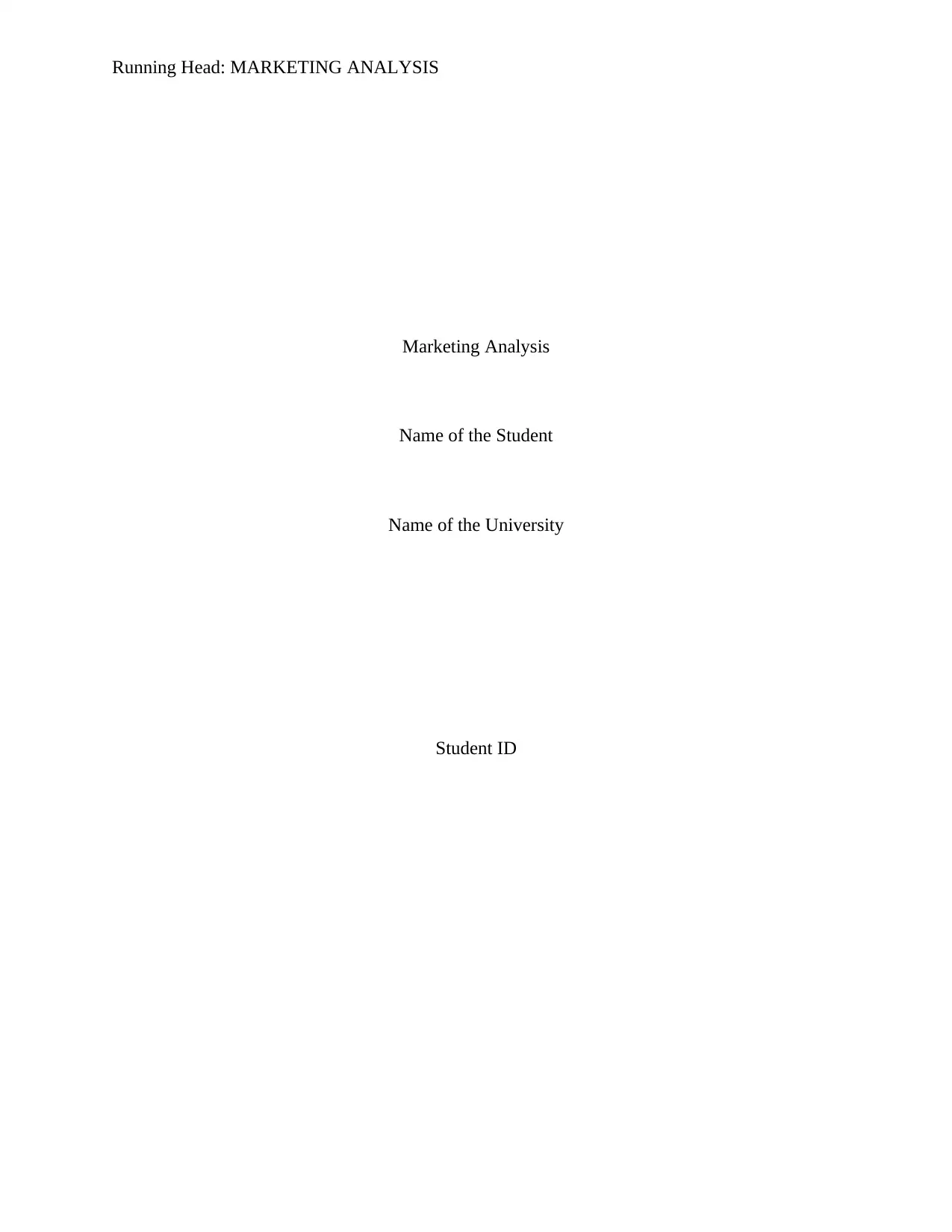
Running Head: MARKETING ANALYSIS
Marketing Analysis
Name of the Student
Name of the University
Student ID
Marketing Analysis
Name of the Student
Name of the University
Student ID
Secure Best Marks with AI Grader
Need help grading? Try our AI Grader for instant feedback on your assignments.
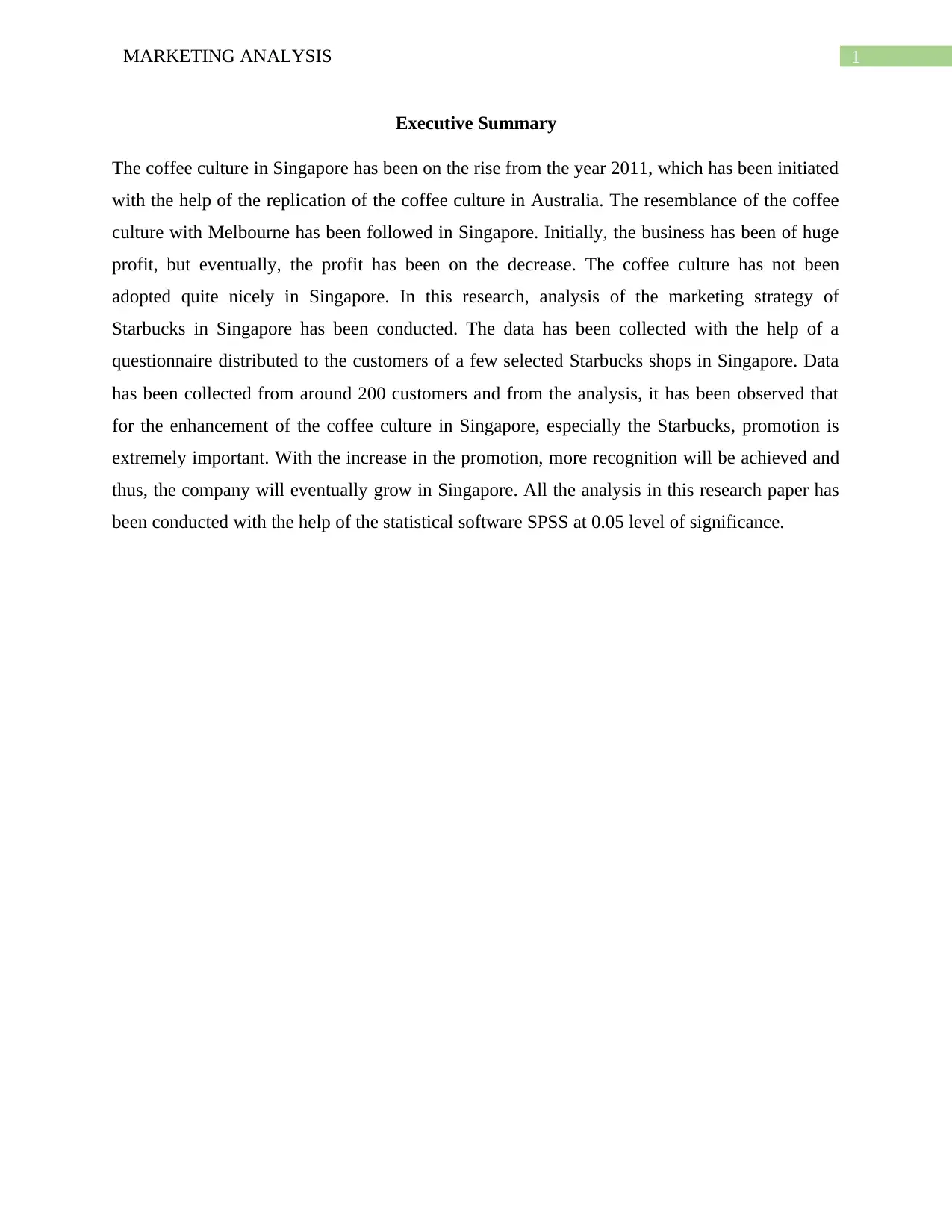
1MARKETING ANALYSIS
Executive Summary
The coffee culture in Singapore has been on the rise from the year 2011, which has been initiated
with the help of the replication of the coffee culture in Australia. The resemblance of the coffee
culture with Melbourne has been followed in Singapore. Initially, the business has been of huge
profit, but eventually, the profit has been on the decrease. The coffee culture has not been
adopted quite nicely in Singapore. In this research, analysis of the marketing strategy of
Starbucks in Singapore has been conducted. The data has been collected with the help of a
questionnaire distributed to the customers of a few selected Starbucks shops in Singapore. Data
has been collected from around 200 customers and from the analysis, it has been observed that
for the enhancement of the coffee culture in Singapore, especially the Starbucks, promotion is
extremely important. With the increase in the promotion, more recognition will be achieved and
thus, the company will eventually grow in Singapore. All the analysis in this research paper has
been conducted with the help of the statistical software SPSS at 0.05 level of significance.
Executive Summary
The coffee culture in Singapore has been on the rise from the year 2011, which has been initiated
with the help of the replication of the coffee culture in Australia. The resemblance of the coffee
culture with Melbourne has been followed in Singapore. Initially, the business has been of huge
profit, but eventually, the profit has been on the decrease. The coffee culture has not been
adopted quite nicely in Singapore. In this research, analysis of the marketing strategy of
Starbucks in Singapore has been conducted. The data has been collected with the help of a
questionnaire distributed to the customers of a few selected Starbucks shops in Singapore. Data
has been collected from around 200 customers and from the analysis, it has been observed that
for the enhancement of the coffee culture in Singapore, especially the Starbucks, promotion is
extremely important. With the increase in the promotion, more recognition will be achieved and
thus, the company will eventually grow in Singapore. All the analysis in this research paper has
been conducted with the help of the statistical software SPSS at 0.05 level of significance.
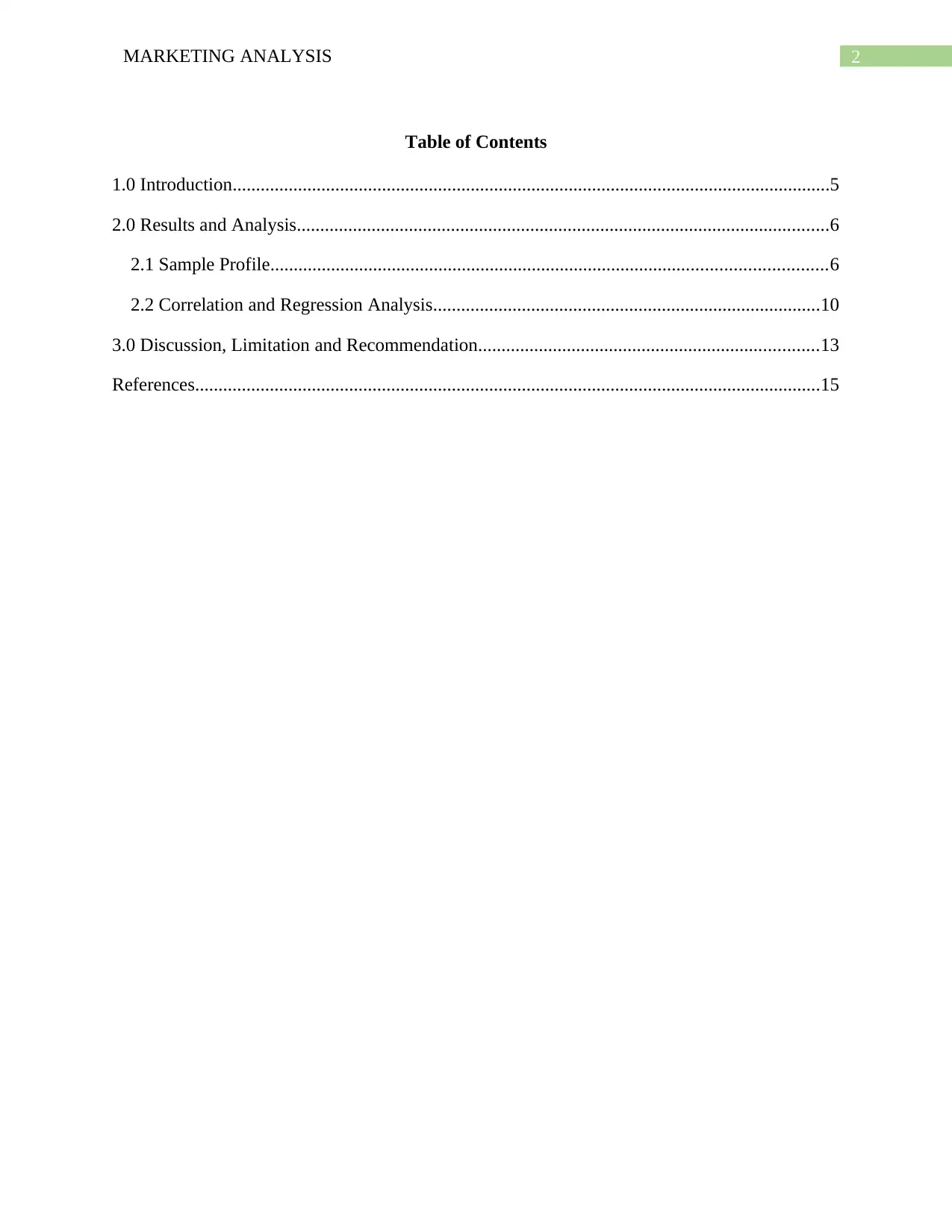
2MARKETING ANALYSIS
Table of Contents
1.0 Introduction................................................................................................................................5
2.0 Results and Analysis..................................................................................................................6
2.1 Sample Profile.......................................................................................................................6
2.2 Correlation and Regression Analysis...................................................................................10
3.0 Discussion, Limitation and Recommendation.........................................................................13
References......................................................................................................................................15
Table of Contents
1.0 Introduction................................................................................................................................5
2.0 Results and Analysis..................................................................................................................6
2.1 Sample Profile.......................................................................................................................6
2.2 Correlation and Regression Analysis...................................................................................10
3.0 Discussion, Limitation and Recommendation.........................................................................13
References......................................................................................................................................15

3MARKETING ANALYSIS
List of Tables
Table 1: Gender of Respondent....................................................................................................6
Table 2: : Age of respondent.........................................................................................................7
Table 3: Income of respondents....................................................................................................8
Table 4: Race of respondent.........................................................................................................9
Table 5: Correlation Matrix.......................................................................................................10
Table 6: Regression Analysis......................................................................................................11
List of Tables
Table 1: Gender of Respondent....................................................................................................6
Table 2: : Age of respondent.........................................................................................................7
Table 3: Income of respondents....................................................................................................8
Table 4: Race of respondent.........................................................................................................9
Table 5: Correlation Matrix.......................................................................................................10
Table 6: Regression Analysis......................................................................................................11
Paraphrase This Document
Need a fresh take? Get an instant paraphrase of this document with our AI Paraphraser
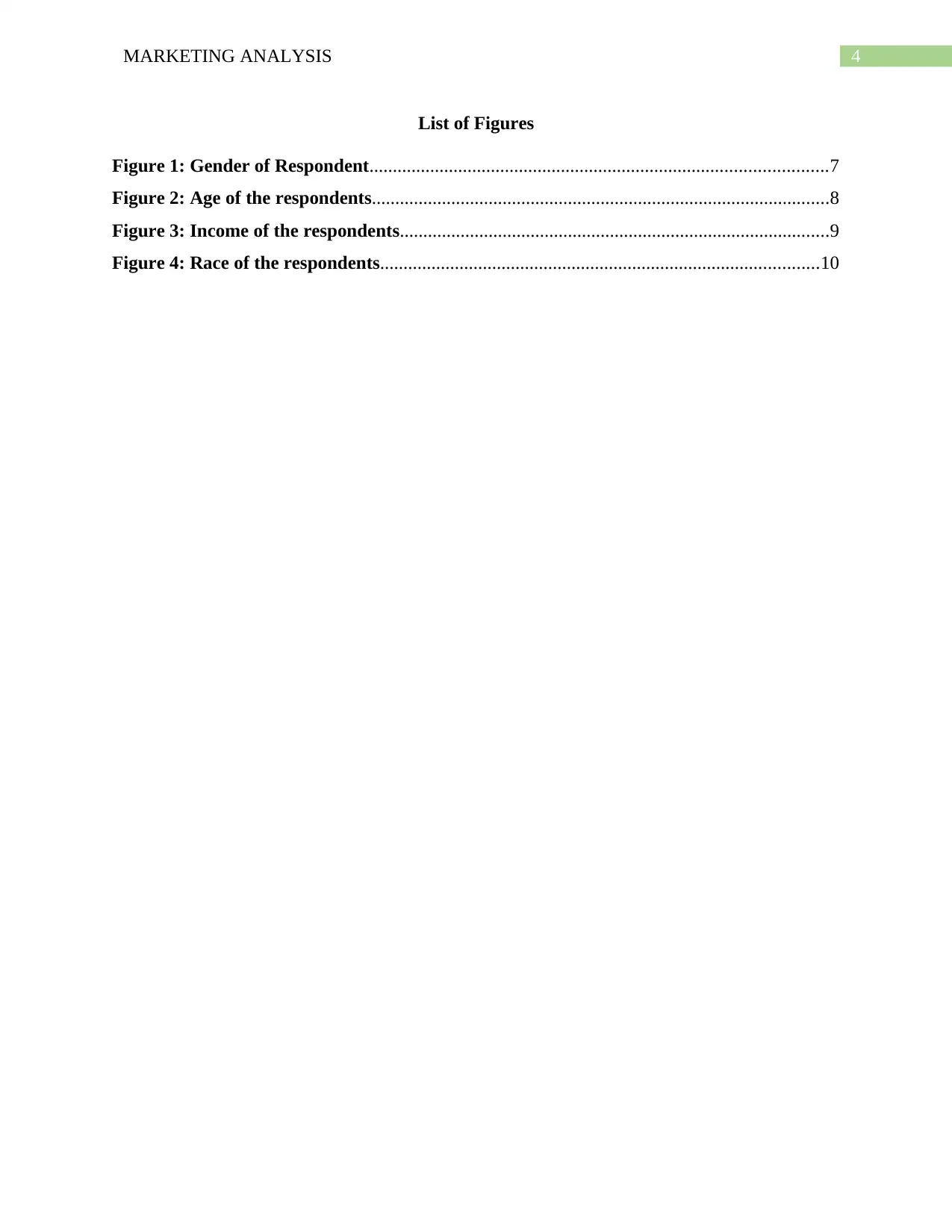
4MARKETING ANALYSIS
List of Figures
Figure 1: Gender of Respondent..................................................................................................7
Figure 2: Age of the respondents..................................................................................................8
Figure 3: Income of the respondents............................................................................................9
Figure 4: Race of the respondents..............................................................................................10
List of Figures
Figure 1: Gender of Respondent..................................................................................................7
Figure 2: Age of the respondents..................................................................................................8
Figure 3: Income of the respondents............................................................................................9
Figure 4: Race of the respondents..............................................................................................10
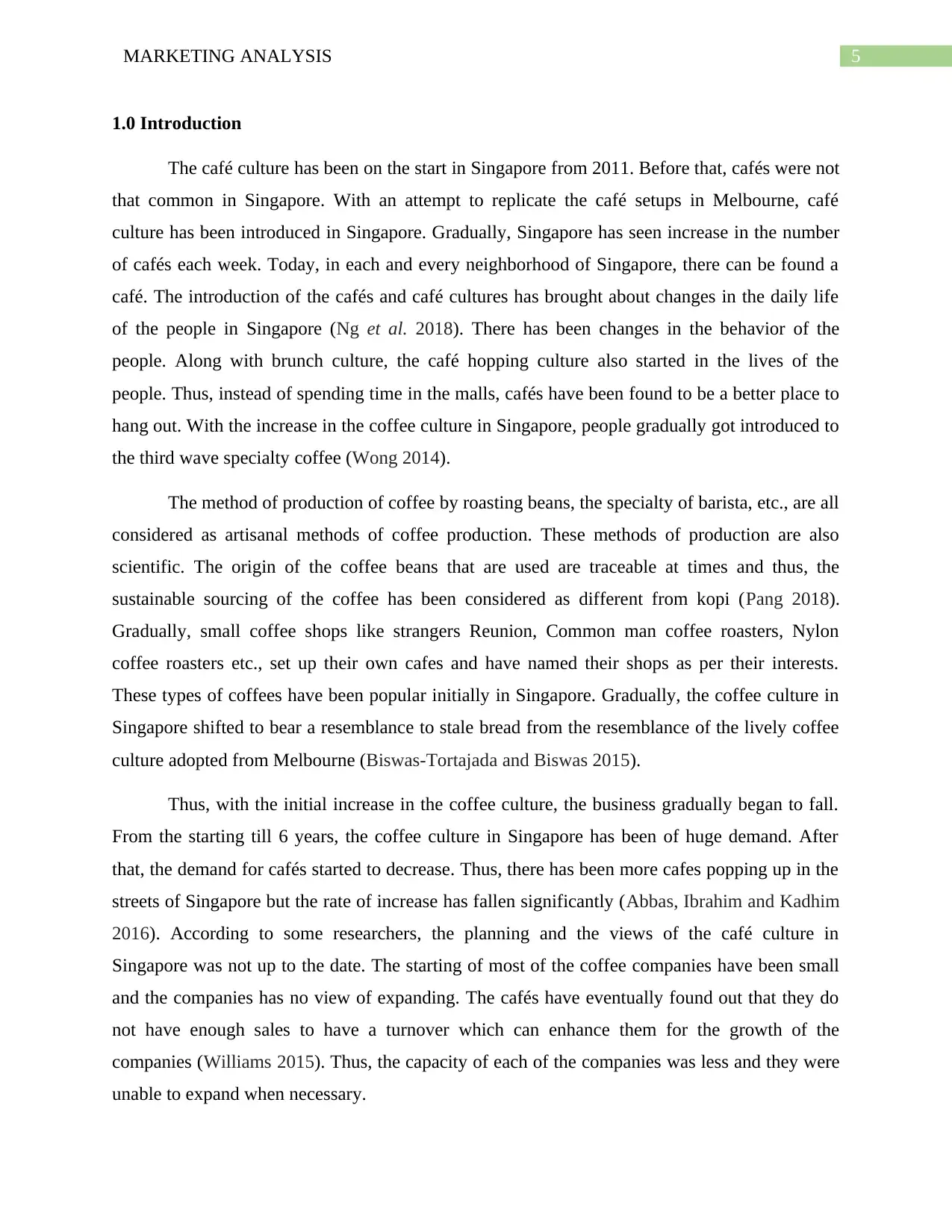
5MARKETING ANALYSIS
1.0 Introduction
The café culture has been on the start in Singapore from 2011. Before that, cafés were not
that common in Singapore. With an attempt to replicate the café setups in Melbourne, café
culture has been introduced in Singapore. Gradually, Singapore has seen increase in the number
of cafés each week. Today, in each and every neighborhood of Singapore, there can be found a
café. The introduction of the cafés and café cultures has brought about changes in the daily life
of the people in Singapore (Ng et al. 2018). There has been changes in the behavior of the
people. Along with brunch culture, the café hopping culture also started in the lives of the
people. Thus, instead of spending time in the malls, cafés have been found to be a better place to
hang out. With the increase in the coffee culture in Singapore, people gradually got introduced to
the third wave specialty coffee (Wong 2014).
The method of production of coffee by roasting beans, the specialty of barista, etc., are all
considered as artisanal methods of coffee production. These methods of production are also
scientific. The origin of the coffee beans that are used are traceable at times and thus, the
sustainable sourcing of the coffee has been considered as different from kopi (Pang 2018).
Gradually, small coffee shops like strangers Reunion, Common man coffee roasters, Nylon
coffee roasters etc., set up their own cafes and have named their shops as per their interests.
These types of coffees have been popular initially in Singapore. Gradually, the coffee culture in
Singapore shifted to bear a resemblance to stale bread from the resemblance of the lively coffee
culture adopted from Melbourne (Biswas-Tortajada and Biswas 2015).
Thus, with the initial increase in the coffee culture, the business gradually began to fall.
From the starting till 6 years, the coffee culture in Singapore has been of huge demand. After
that, the demand for cafés started to decrease. Thus, there has been more cafes popping up in the
streets of Singapore but the rate of increase has fallen significantly (Abbas, Ibrahim and Kadhim
2016). According to some researchers, the planning and the views of the café culture in
Singapore was not up to the date. The starting of most of the coffee companies have been small
and the companies has no view of expanding. The cafés have eventually found out that they do
not have enough sales to have a turnover which can enhance them for the growth of the
companies (Williams 2015). Thus, the capacity of each of the companies was less and they were
unable to expand when necessary.
1.0 Introduction
The café culture has been on the start in Singapore from 2011. Before that, cafés were not
that common in Singapore. With an attempt to replicate the café setups in Melbourne, café
culture has been introduced in Singapore. Gradually, Singapore has seen increase in the number
of cafés each week. Today, in each and every neighborhood of Singapore, there can be found a
café. The introduction of the cafés and café cultures has brought about changes in the daily life
of the people in Singapore (Ng et al. 2018). There has been changes in the behavior of the
people. Along with brunch culture, the café hopping culture also started in the lives of the
people. Thus, instead of spending time in the malls, cafés have been found to be a better place to
hang out. With the increase in the coffee culture in Singapore, people gradually got introduced to
the third wave specialty coffee (Wong 2014).
The method of production of coffee by roasting beans, the specialty of barista, etc., are all
considered as artisanal methods of coffee production. These methods of production are also
scientific. The origin of the coffee beans that are used are traceable at times and thus, the
sustainable sourcing of the coffee has been considered as different from kopi (Pang 2018).
Gradually, small coffee shops like strangers Reunion, Common man coffee roasters, Nylon
coffee roasters etc., set up their own cafes and have named their shops as per their interests.
These types of coffees have been popular initially in Singapore. Gradually, the coffee culture in
Singapore shifted to bear a resemblance to stale bread from the resemblance of the lively coffee
culture adopted from Melbourne (Biswas-Tortajada and Biswas 2015).
Thus, with the initial increase in the coffee culture, the business gradually began to fall.
From the starting till 6 years, the coffee culture in Singapore has been of huge demand. After
that, the demand for cafés started to decrease. Thus, there has been more cafes popping up in the
streets of Singapore but the rate of increase has fallen significantly (Abbas, Ibrahim and Kadhim
2016). According to some researchers, the planning and the views of the café culture in
Singapore was not up to the date. The starting of most of the coffee companies have been small
and the companies has no view of expanding. The cafés have eventually found out that they do
not have enough sales to have a turnover which can enhance them for the growth of the
companies (Williams 2015). Thus, the capacity of each of the companies was less and they were
unable to expand when necessary.

6MARKETING ANALYSIS
This research is mainly based on the marketing analysis of the coffee shop Starbucks.
With reference to the discussion on the coffee market in Singapore, the following are the
objectives of this research study:
To identify what are the demographic and behavioral profiles of the consumers of
Starbucks.
To identify the factors that are significant for purchasing behavior of the consumers.
To establish the relationship between the communications provided in the market with
the decision of purchase.
To provide suitable recommendations on the basis of the results obtained by analyzing
the data.
2.0 Results and Analysis
In order to conduct this research, some data has been collected from the consumers of
Starbucks in Singapore. The main aim of this research is to understand the purchasing behavior
of the consumers of this store. Thus, to conduct this research and for the purpose of the
collection of the data, a survey questionnaire has been prepared and distributed to some
randomly selected Starbucks stores in Singapore.
2.1 Sample Profile
From the distributed questionnaires, 201 responses have been returned, which will be
considered as valid for the research. There are though a lot of missing values in the data collected
as a result of the responses from the customers.
This research is mainly based on the marketing analysis of the coffee shop Starbucks.
With reference to the discussion on the coffee market in Singapore, the following are the
objectives of this research study:
To identify what are the demographic and behavioral profiles of the consumers of
Starbucks.
To identify the factors that are significant for purchasing behavior of the consumers.
To establish the relationship between the communications provided in the market with
the decision of purchase.
To provide suitable recommendations on the basis of the results obtained by analyzing
the data.
2.0 Results and Analysis
In order to conduct this research, some data has been collected from the consumers of
Starbucks in Singapore. The main aim of this research is to understand the purchasing behavior
of the consumers of this store. Thus, to conduct this research and for the purpose of the
collection of the data, a survey questionnaire has been prepared and distributed to some
randomly selected Starbucks stores in Singapore.
2.1 Sample Profile
From the distributed questionnaires, 201 responses have been returned, which will be
considered as valid for the research. There are though a lot of missing values in the data collected
as a result of the responses from the customers.
Secure Best Marks with AI Grader
Need help grading? Try our AI Grader for instant feedback on your assignments.

7MARKETING ANALYSIS
Figure 1: Gender of Respondent
Table 1: Gender of Respondent
Frequency Percent Valid Percent Cumulative Percent
Valid
Female 111 55.2 56.6 56.6
Male 85 42.3 43.4 100.0
Total 196 97.5 100.0
Missing System 5 2.5
Total 201 100.0
From the demographic analysis of the gender of the respondents given in table 1 and
figure 1, it can be seen that the valid percentage of females in the sample is 56 percent, and 43
percent of the respondents are males. From here, it can be said that the number of females
visiting the Starbucks coffee shop in Singapore is more than the number of males. Thus, females
are more prone to visiting Starbucks.
Figure 1: Gender of Respondent
Table 1: Gender of Respondent
Frequency Percent Valid Percent Cumulative Percent
Valid
Female 111 55.2 56.6 56.6
Male 85 42.3 43.4 100.0
Total 196 97.5 100.0
Missing System 5 2.5
Total 201 100.0
From the demographic analysis of the gender of the respondents given in table 1 and
figure 1, it can be seen that the valid percentage of females in the sample is 56 percent, and 43
percent of the respondents are males. From here, it can be said that the number of females
visiting the Starbucks coffee shop in Singapore is more than the number of males. Thus, females
are more prone to visiting Starbucks.
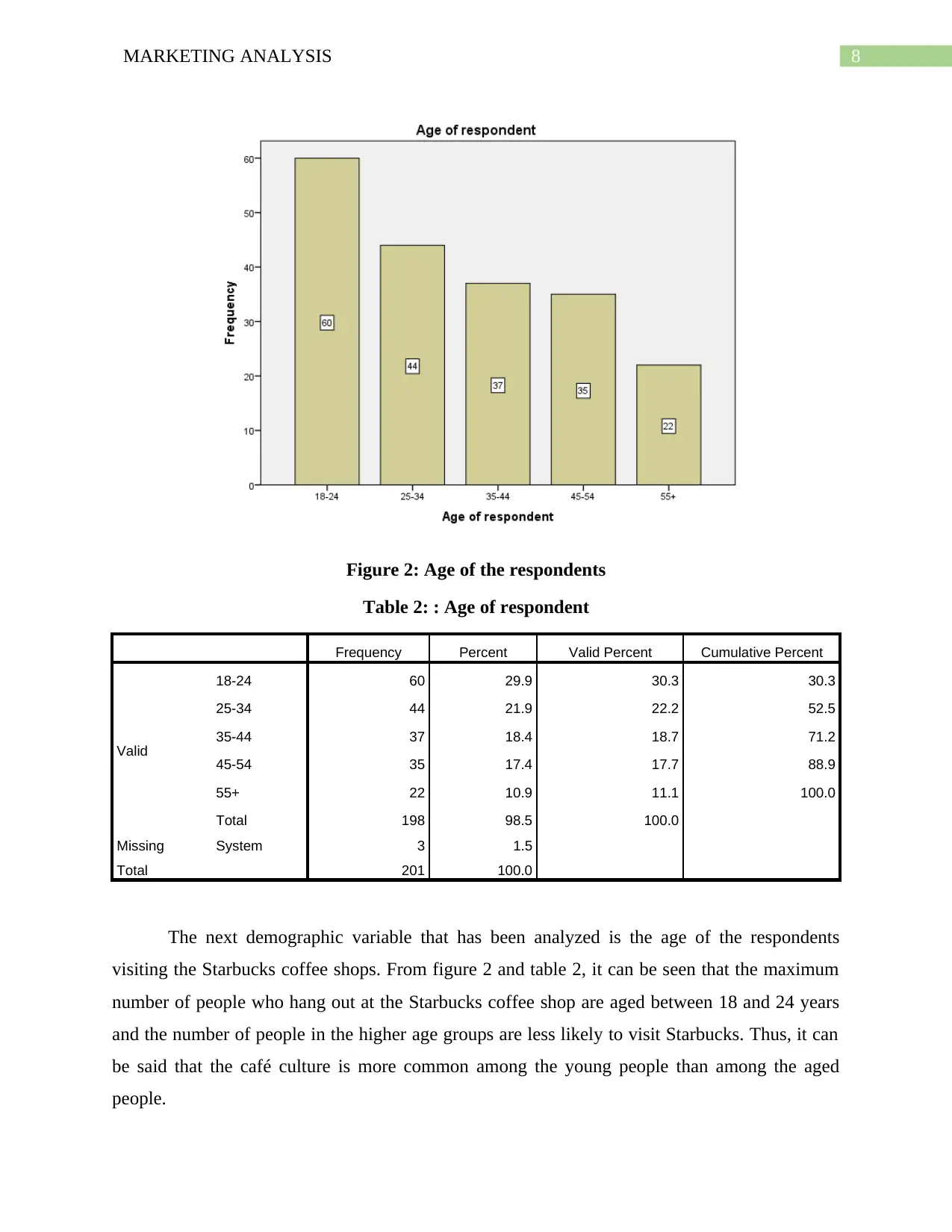
8MARKETING ANALYSIS
Figure 2: Age of the respondents
Table 2: : Age of respondent
Frequency Percent Valid Percent Cumulative Percent
Valid
18-24 60 29.9 30.3 30.3
25-34 44 21.9 22.2 52.5
35-44 37 18.4 18.7 71.2
45-54 35 17.4 17.7 88.9
55+ 22 10.9 11.1 100.0
Total 198 98.5 100.0
Missing System 3 1.5
Total 201 100.0
The next demographic variable that has been analyzed is the age of the respondents
visiting the Starbucks coffee shops. From figure 2 and table 2, it can be seen that the maximum
number of people who hang out at the Starbucks coffee shop are aged between 18 and 24 years
and the number of people in the higher age groups are less likely to visit Starbucks. Thus, it can
be said that the café culture is more common among the young people than among the aged
people.
Figure 2: Age of the respondents
Table 2: : Age of respondent
Frequency Percent Valid Percent Cumulative Percent
Valid
18-24 60 29.9 30.3 30.3
25-34 44 21.9 22.2 52.5
35-44 37 18.4 18.7 71.2
45-54 35 17.4 17.7 88.9
55+ 22 10.9 11.1 100.0
Total 198 98.5 100.0
Missing System 3 1.5
Total 201 100.0
The next demographic variable that has been analyzed is the age of the respondents
visiting the Starbucks coffee shops. From figure 2 and table 2, it can be seen that the maximum
number of people who hang out at the Starbucks coffee shop are aged between 18 and 24 years
and the number of people in the higher age groups are less likely to visit Starbucks. Thus, it can
be said that the café culture is more common among the young people than among the aged
people.
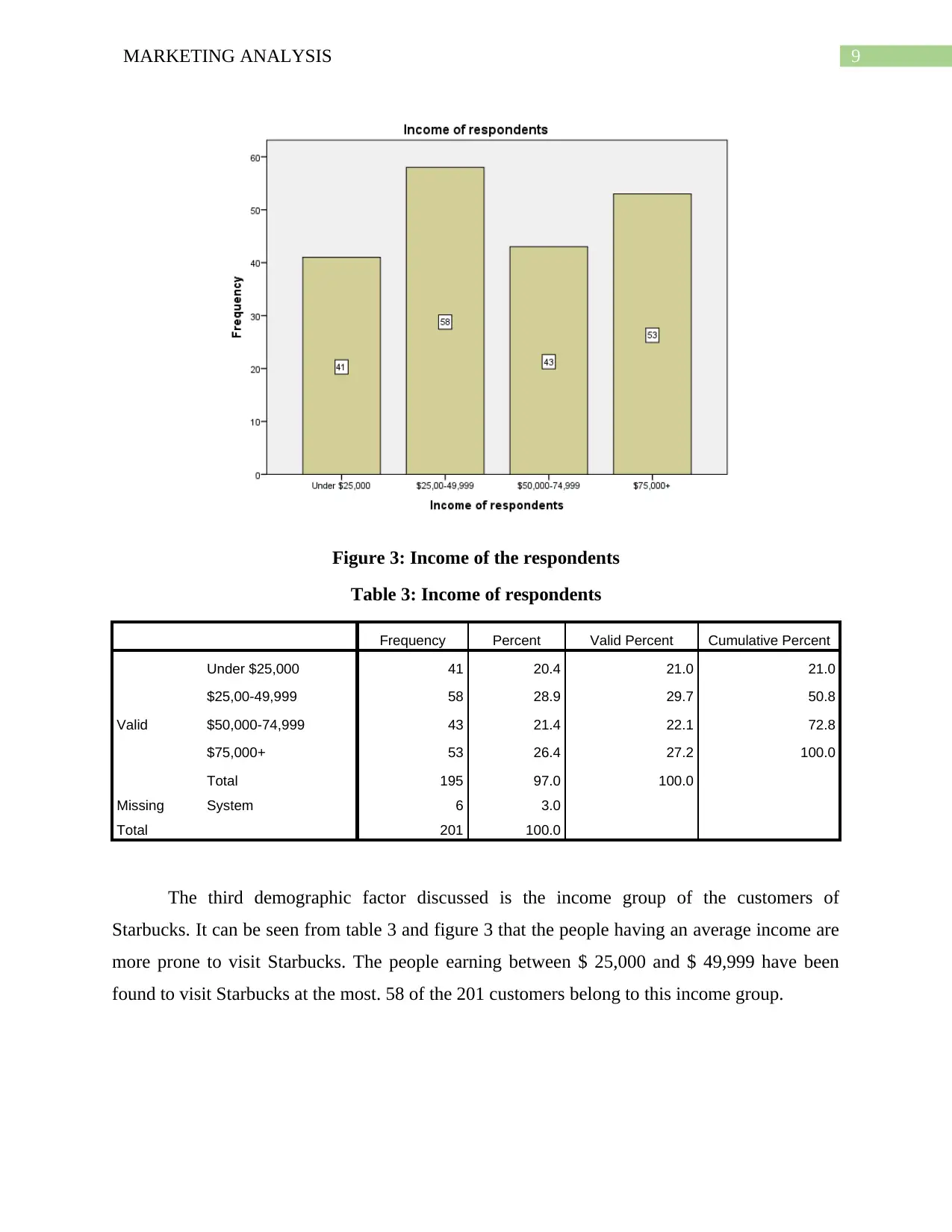
9MARKETING ANALYSIS
Figure 3: Income of the respondents
Table 3: Income of respondents
Frequency Percent Valid Percent Cumulative Percent
Valid
Under $25,000 41 20.4 21.0 21.0
$25,00-49,999 58 28.9 29.7 50.8
$50,000-74,999 43 21.4 22.1 72.8
$75,000+ 53 26.4 27.2 100.0
Total 195 97.0 100.0
Missing System 6 3.0
Total 201 100.0
The third demographic factor discussed is the income group of the customers of
Starbucks. It can be seen from table 3 and figure 3 that the people having an average income are
more prone to visit Starbucks. The people earning between $ 25,000 and $ 49,999 have been
found to visit Starbucks at the most. 58 of the 201 customers belong to this income group.
Figure 3: Income of the respondents
Table 3: Income of respondents
Frequency Percent Valid Percent Cumulative Percent
Valid
Under $25,000 41 20.4 21.0 21.0
$25,00-49,999 58 28.9 29.7 50.8
$50,000-74,999 43 21.4 22.1 72.8
$75,000+ 53 26.4 27.2 100.0
Total 195 97.0 100.0
Missing System 6 3.0
Total 201 100.0
The third demographic factor discussed is the income group of the customers of
Starbucks. It can be seen from table 3 and figure 3 that the people having an average income are
more prone to visit Starbucks. The people earning between $ 25,000 and $ 49,999 have been
found to visit Starbucks at the most. 58 of the 201 customers belong to this income group.
Paraphrase This Document
Need a fresh take? Get an instant paraphrase of this document with our AI Paraphraser
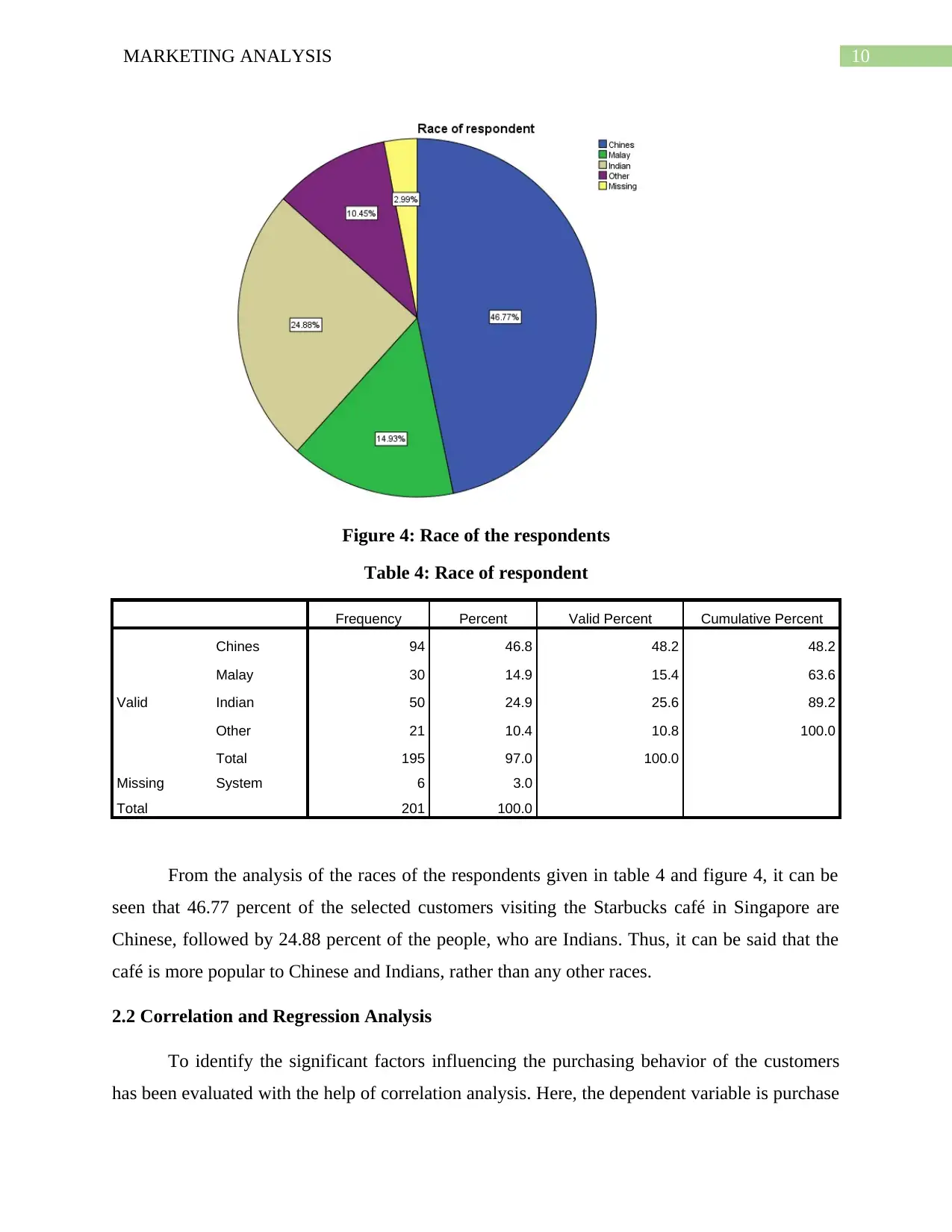
10MARKETING ANALYSIS
Figure 4: Race of the respondents
Table 4: Race of respondent
Frequency Percent Valid Percent Cumulative Percent
Valid
Chines 94 46.8 48.2 48.2
Malay 30 14.9 15.4 63.6
Indian 50 24.9 25.6 89.2
Other 21 10.4 10.8 100.0
Total 195 97.0 100.0
Missing System 6 3.0
Total 201 100.0
From the analysis of the races of the respondents given in table 4 and figure 4, it can be
seen that 46.77 percent of the selected customers visiting the Starbucks café in Singapore are
Chinese, followed by 24.88 percent of the people, who are Indians. Thus, it can be said that the
café is more popular to Chinese and Indians, rather than any other races.
2.2 Correlation and Regression Analysis
To identify the significant factors influencing the purchasing behavior of the customers
has been evaluated with the help of correlation analysis. Here, the dependent variable is purchase
Figure 4: Race of the respondents
Table 4: Race of respondent
Frequency Percent Valid Percent Cumulative Percent
Valid
Chines 94 46.8 48.2 48.2
Malay 30 14.9 15.4 63.6
Indian 50 24.9 25.6 89.2
Other 21 10.4 10.8 100.0
Total 195 97.0 100.0
Missing System 6 3.0
Total 201 100.0
From the analysis of the races of the respondents given in table 4 and figure 4, it can be
seen that 46.77 percent of the selected customers visiting the Starbucks café in Singapore are
Chinese, followed by 24.88 percent of the people, who are Indians. Thus, it can be said that the
café is more popular to Chinese and Indians, rather than any other races.
2.2 Correlation and Regression Analysis
To identify the significant factors influencing the purchasing behavior of the customers
has been evaluated with the help of correlation analysis. Here, the dependent variable is purchase
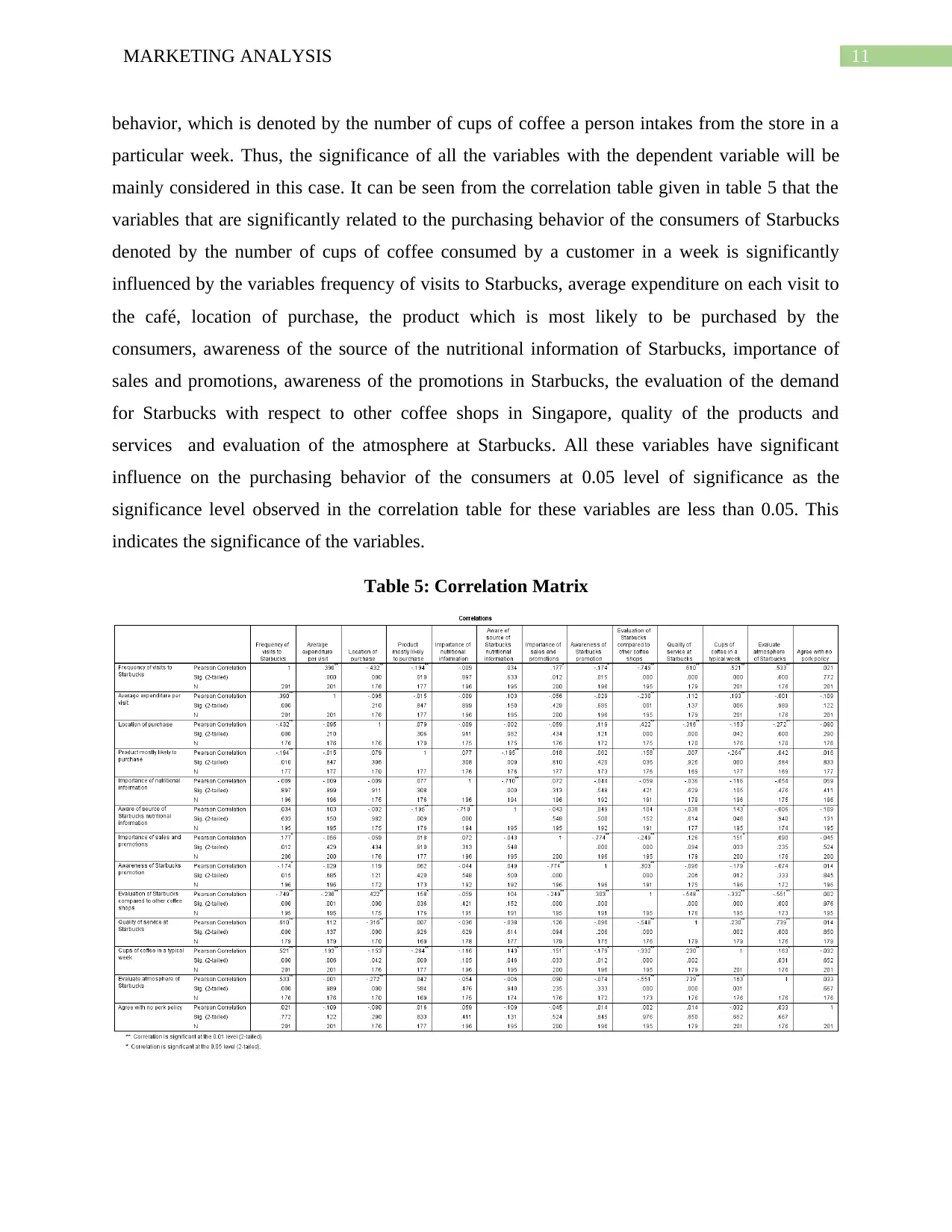
11MARKETING ANALYSIS
behavior, which is denoted by the number of cups of coffee a person intakes from the store in a
particular week. Thus, the significance of all the variables with the dependent variable will be
mainly considered in this case. It can be seen from the correlation table given in table 5 that the
variables that are significantly related to the purchasing behavior of the consumers of Starbucks
denoted by the number of cups of coffee consumed by a customer in a week is significantly
influenced by the variables frequency of visits to Starbucks, average expenditure on each visit to
the café, location of purchase, the product which is most likely to be purchased by the
consumers, awareness of the source of the nutritional information of Starbucks, importance of
sales and promotions, awareness of the promotions in Starbucks, the evaluation of the demand
for Starbucks with respect to other coffee shops in Singapore, quality of the products and
services and evaluation of the atmosphere at Starbucks. All these variables have significant
influence on the purchasing behavior of the consumers at 0.05 level of significance as the
significance level observed in the correlation table for these variables are less than 0.05. This
indicates the significance of the variables.
Table 5: Correlation Matrix
behavior, which is denoted by the number of cups of coffee a person intakes from the store in a
particular week. Thus, the significance of all the variables with the dependent variable will be
mainly considered in this case. It can be seen from the correlation table given in table 5 that the
variables that are significantly related to the purchasing behavior of the consumers of Starbucks
denoted by the number of cups of coffee consumed by a customer in a week is significantly
influenced by the variables frequency of visits to Starbucks, average expenditure on each visit to
the café, location of purchase, the product which is most likely to be purchased by the
consumers, awareness of the source of the nutritional information of Starbucks, importance of
sales and promotions, awareness of the promotions in Starbucks, the evaluation of the demand
for Starbucks with respect to other coffee shops in Singapore, quality of the products and
services and evaluation of the atmosphere at Starbucks. All these variables have significant
influence on the purchasing behavior of the consumers at 0.05 level of significance as the
significance level observed in the correlation table for these variables are less than 0.05. This
indicates the significance of the variables.
Table 5: Correlation Matrix
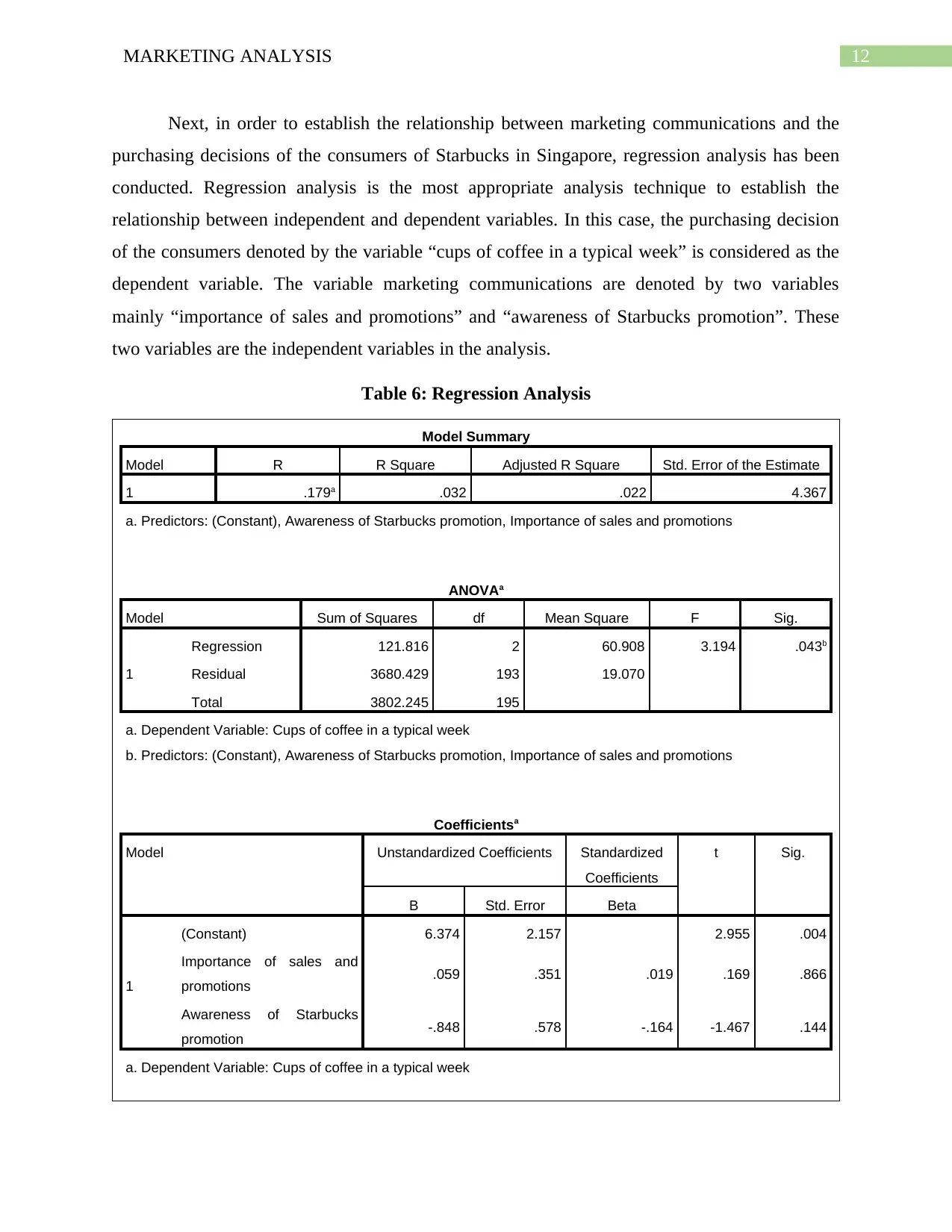
12MARKETING ANALYSIS
Next, in order to establish the relationship between marketing communications and the
purchasing decisions of the consumers of Starbucks in Singapore, regression analysis has been
conducted. Regression analysis is the most appropriate analysis technique to establish the
relationship between independent and dependent variables. In this case, the purchasing decision
of the consumers denoted by the variable “cups of coffee in a typical week” is considered as the
dependent variable. The variable marketing communications are denoted by two variables
mainly “importance of sales and promotions” and “awareness of Starbucks promotion”. These
two variables are the independent variables in the analysis.
Table 6: Regression Analysis
Model Summary
Model R R Square Adjusted R Square Std. Error of the Estimate
1 .179a .032 .022 4.367
a. Predictors: (Constant), Awareness of Starbucks promotion, Importance of sales and promotions
ANOVAa
Model Sum of Squares df Mean Square F Sig.
1
Regression 121.816 2 60.908 3.194 .043b
Residual 3680.429 193 19.070
Total 3802.245 195
a. Dependent Variable: Cups of coffee in a typical week
b. Predictors: (Constant), Awareness of Starbucks promotion, Importance of sales and promotions
Coefficientsa
Model Unstandardized Coefficients Standardized
Coefficients
t Sig.
B Std. Error Beta
1
(Constant) 6.374 2.157 2.955 .004
Importance of sales and
promotions .059 .351 .019 .169 .866
Awareness of Starbucks
promotion -.848 .578 -.164 -1.467 .144
a. Dependent Variable: Cups of coffee in a typical week
Next, in order to establish the relationship between marketing communications and the
purchasing decisions of the consumers of Starbucks in Singapore, regression analysis has been
conducted. Regression analysis is the most appropriate analysis technique to establish the
relationship between independent and dependent variables. In this case, the purchasing decision
of the consumers denoted by the variable “cups of coffee in a typical week” is considered as the
dependent variable. The variable marketing communications are denoted by two variables
mainly “importance of sales and promotions” and “awareness of Starbucks promotion”. These
two variables are the independent variables in the analysis.
Table 6: Regression Analysis
Model Summary
Model R R Square Adjusted R Square Std. Error of the Estimate
1 .179a .032 .022 4.367
a. Predictors: (Constant), Awareness of Starbucks promotion, Importance of sales and promotions
ANOVAa
Model Sum of Squares df Mean Square F Sig.
1
Regression 121.816 2 60.908 3.194 .043b
Residual 3680.429 193 19.070
Total 3802.245 195
a. Dependent Variable: Cups of coffee in a typical week
b. Predictors: (Constant), Awareness of Starbucks promotion, Importance of sales and promotions
Coefficientsa
Model Unstandardized Coefficients Standardized
Coefficients
t Sig.
B Std. Error Beta
1
(Constant) 6.374 2.157 2.955 .004
Importance of sales and
promotions .059 .351 .019 .169 .866
Awareness of Starbucks
promotion -.848 .578 -.164 -1.467 .144
a. Dependent Variable: Cups of coffee in a typical week
Secure Best Marks with AI Grader
Need help grading? Try our AI Grader for instant feedback on your assignments.
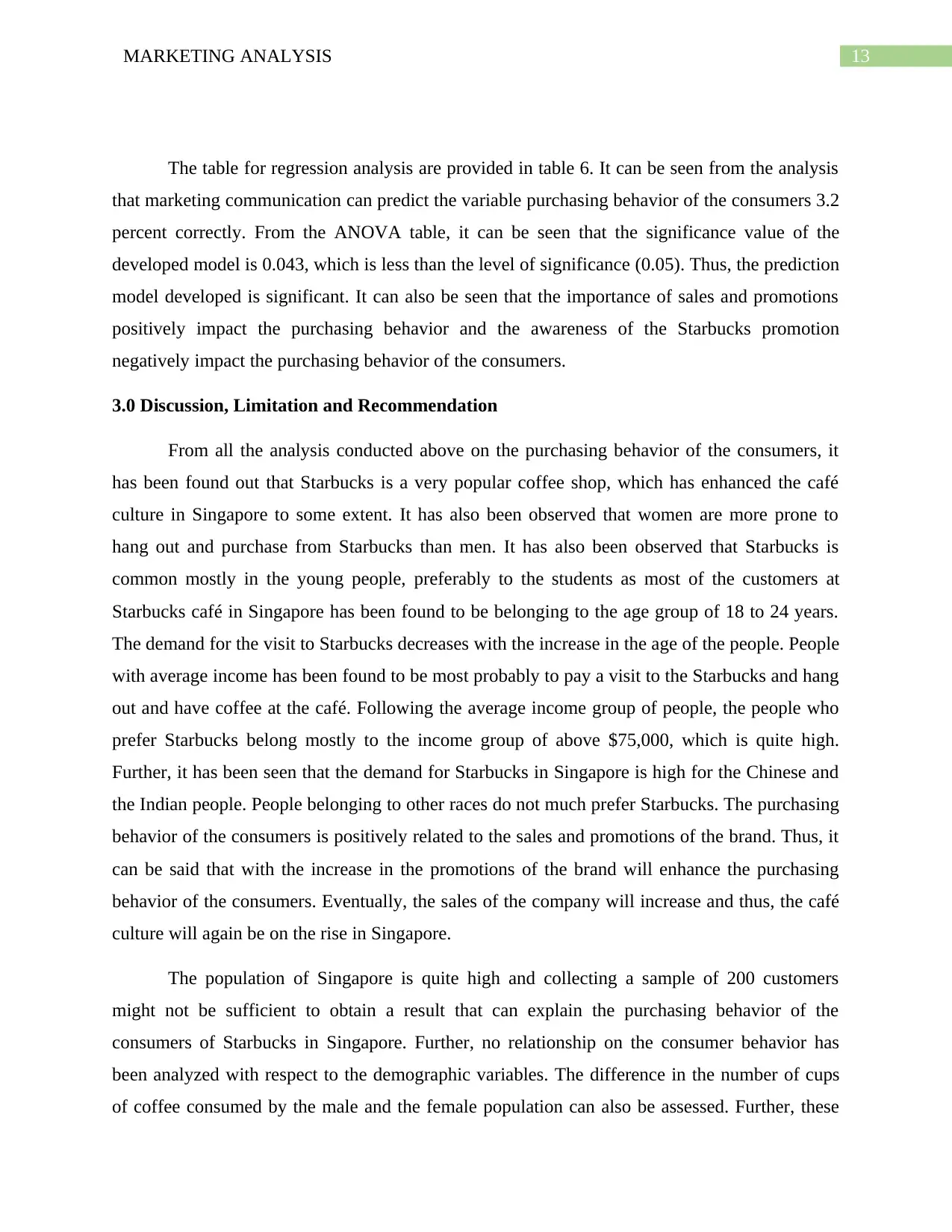
13MARKETING ANALYSIS
The table for regression analysis are provided in table 6. It can be seen from the analysis
that marketing communication can predict the variable purchasing behavior of the consumers 3.2
percent correctly. From the ANOVA table, it can be seen that the significance value of the
developed model is 0.043, which is less than the level of significance (0.05). Thus, the prediction
model developed is significant. It can also be seen that the importance of sales and promotions
positively impact the purchasing behavior and the awareness of the Starbucks promotion
negatively impact the purchasing behavior of the consumers.
3.0 Discussion, Limitation and Recommendation
From all the analysis conducted above on the purchasing behavior of the consumers, it
has been found out that Starbucks is a very popular coffee shop, which has enhanced the café
culture in Singapore to some extent. It has also been observed that women are more prone to
hang out and purchase from Starbucks than men. It has also been observed that Starbucks is
common mostly in the young people, preferably to the students as most of the customers at
Starbucks café in Singapore has been found to be belonging to the age group of 18 to 24 years.
The demand for the visit to Starbucks decreases with the increase in the age of the people. People
with average income has been found to be most probably to pay a visit to the Starbucks and hang
out and have coffee at the café. Following the average income group of people, the people who
prefer Starbucks belong mostly to the income group of above $75,000, which is quite high.
Further, it has been seen that the demand for Starbucks in Singapore is high for the Chinese and
the Indian people. People belonging to other races do not much prefer Starbucks. The purchasing
behavior of the consumers is positively related to the sales and promotions of the brand. Thus, it
can be said that with the increase in the promotions of the brand will enhance the purchasing
behavior of the consumers. Eventually, the sales of the company will increase and thus, the café
culture will again be on the rise in Singapore.
The population of Singapore is quite high and collecting a sample of 200 customers
might not be sufficient to obtain a result that can explain the purchasing behavior of the
consumers of Starbucks in Singapore. Further, no relationship on the consumer behavior has
been analyzed with respect to the demographic variables. The difference in the number of cups
of coffee consumed by the male and the female population can also be assessed. Further, these
The table for regression analysis are provided in table 6. It can be seen from the analysis
that marketing communication can predict the variable purchasing behavior of the consumers 3.2
percent correctly. From the ANOVA table, it can be seen that the significance value of the
developed model is 0.043, which is less than the level of significance (0.05). Thus, the prediction
model developed is significant. It can also be seen that the importance of sales and promotions
positively impact the purchasing behavior and the awareness of the Starbucks promotion
negatively impact the purchasing behavior of the consumers.
3.0 Discussion, Limitation and Recommendation
From all the analysis conducted above on the purchasing behavior of the consumers, it
has been found out that Starbucks is a very popular coffee shop, which has enhanced the café
culture in Singapore to some extent. It has also been observed that women are more prone to
hang out and purchase from Starbucks than men. It has also been observed that Starbucks is
common mostly in the young people, preferably to the students as most of the customers at
Starbucks café in Singapore has been found to be belonging to the age group of 18 to 24 years.
The demand for the visit to Starbucks decreases with the increase in the age of the people. People
with average income has been found to be most probably to pay a visit to the Starbucks and hang
out and have coffee at the café. Following the average income group of people, the people who
prefer Starbucks belong mostly to the income group of above $75,000, which is quite high.
Further, it has been seen that the demand for Starbucks in Singapore is high for the Chinese and
the Indian people. People belonging to other races do not much prefer Starbucks. The purchasing
behavior of the consumers is positively related to the sales and promotions of the brand. Thus, it
can be said that with the increase in the promotions of the brand will enhance the purchasing
behavior of the consumers. Eventually, the sales of the company will increase and thus, the café
culture will again be on the rise in Singapore.
The population of Singapore is quite high and collecting a sample of 200 customers
might not be sufficient to obtain a result that can explain the purchasing behavior of the
consumers of Starbucks in Singapore. Further, no relationship on the consumer behavior has
been analyzed with respect to the demographic variables. The difference in the number of cups
of coffee consumed by the male and the female population can also be assessed. Further, these

14MARKETING ANALYSIS
differences can be evaluated with respect to the age, race as well as the income group of the
consumers. The impact of these variables on the consumer purchasing behavior could have been
computed in this research.
Thus, from the analysis conducted so far, it can be understood clearly that Starbucks is
quite in demand in Singapore. There should be promotions of the brand so that the sales of the
company can be increased as from the analysis, it has been obtained a positive relationship
between the purchasing behavior and sales and promotions. Thus, the promotion of the brand is
extremely important.
differences can be evaluated with respect to the age, race as well as the income group of the
consumers. The impact of these variables on the consumer purchasing behavior could have been
computed in this research.
Thus, from the analysis conducted so far, it can be understood clearly that Starbucks is
quite in demand in Singapore. There should be promotions of the brand so that the sales of the
company can be increased as from the analysis, it has been obtained a positive relationship
between the purchasing behavior and sales and promotions. Thus, the promotion of the brand is
extremely important.
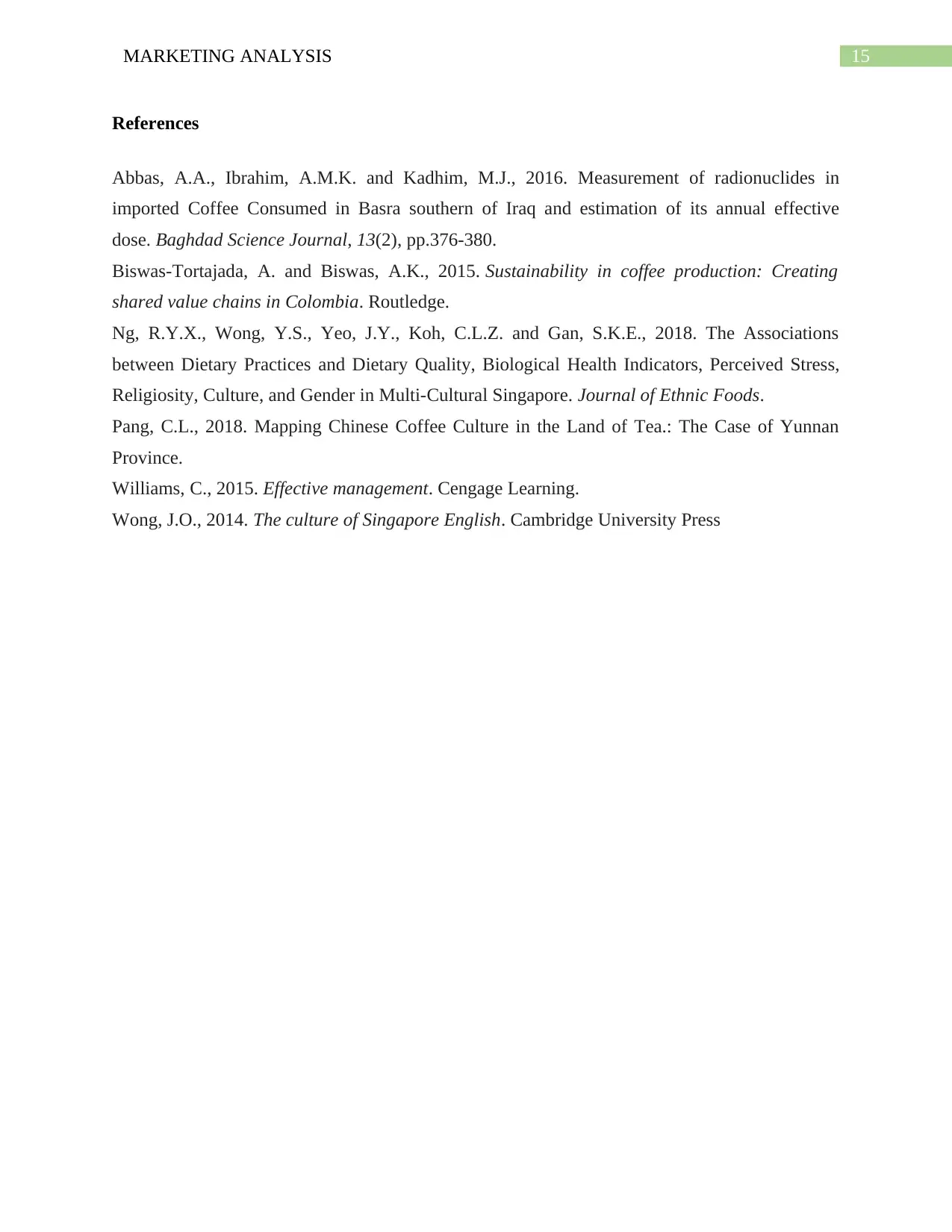
15MARKETING ANALYSIS
References
Abbas, A.A., Ibrahim, A.M.K. and Kadhim, M.J., 2016. Measurement of radionuclides in
imported Coffee Consumed in Basra southern of Iraq and estimation of its annual effective
dose. Baghdad Science Journal, 13(2), pp.376-380.
Biswas-Tortajada, A. and Biswas, A.K., 2015. Sustainability in coffee production: Creating
shared value chains in Colombia. Routledge.
Ng, R.Y.X., Wong, Y.S., Yeo, J.Y., Koh, C.L.Z. and Gan, S.K.E., 2018. The Associations
between Dietary Practices and Dietary Quality, Biological Health Indicators, Perceived Stress,
Religiosity, Culture, and Gender in Multi-Cultural Singapore. Journal of Ethnic Foods.
Pang, C.L., 2018. Mapping Chinese Coffee Culture in the Land of Tea.: The Case of Yunnan
Province.
Williams, C., 2015. Effective management. Cengage Learning.
Wong, J.O., 2014. The culture of Singapore English. Cambridge University Press
References
Abbas, A.A., Ibrahim, A.M.K. and Kadhim, M.J., 2016. Measurement of radionuclides in
imported Coffee Consumed in Basra southern of Iraq and estimation of its annual effective
dose. Baghdad Science Journal, 13(2), pp.376-380.
Biswas-Tortajada, A. and Biswas, A.K., 2015. Sustainability in coffee production: Creating
shared value chains in Colombia. Routledge.
Ng, R.Y.X., Wong, Y.S., Yeo, J.Y., Koh, C.L.Z. and Gan, S.K.E., 2018. The Associations
between Dietary Practices and Dietary Quality, Biological Health Indicators, Perceived Stress,
Religiosity, Culture, and Gender in Multi-Cultural Singapore. Journal of Ethnic Foods.
Pang, C.L., 2018. Mapping Chinese Coffee Culture in the Land of Tea.: The Case of Yunnan
Province.
Williams, C., 2015. Effective management. Cengage Learning.
Wong, J.O., 2014. The culture of Singapore English. Cambridge University Press
1 out of 16
Related Documents
Your All-in-One AI-Powered Toolkit for Academic Success.
+13062052269
info@desklib.com
Available 24*7 on WhatsApp / Email
![[object Object]](/_next/static/media/star-bottom.7253800d.svg)
Unlock your academic potential
© 2024 | Zucol Services PVT LTD | All rights reserved.